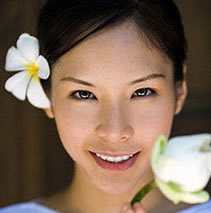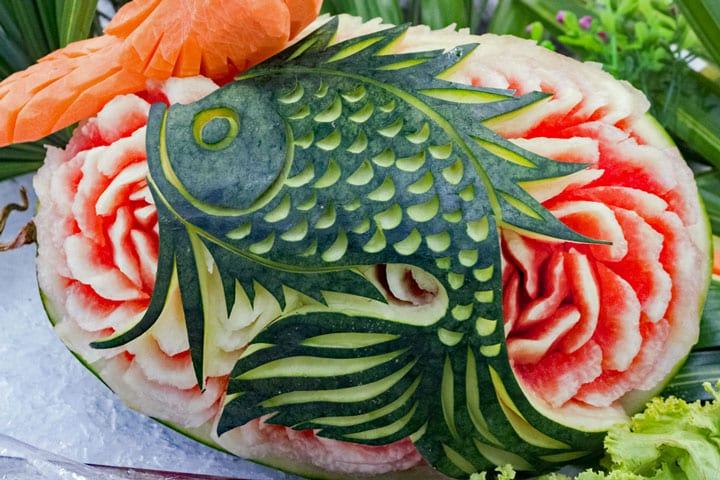Thai fruit carving art Kae Sa Luk
If you ever eat in a somewhat better Thai restaurant, you are probably familiar with it. The served dishes smell good and also look beautiful. On the edge of your plate are small figures cut from carrot, watermelon, cucumber or another fruit or vegetable. The Thai art of making a boat out of a melon, a bird out of a pumpkin or a flower out of a carrot is called Kae Sa Luk.
S
This art form is now practiced in many countries, but in Thailand it has existed for many hundreds of years. There are stories that the art has come over from Japan or China, but in Thailand it is believed that it originated in the 14th century at the court of the kingdom of Sukhothai. It has since remained popular in subsequent kingdoms and Thailand and Kae Sa Luk masterpieces are still offered in temples or used as decorations at weddings.
History
It is interesting to go back in history to know how Kae Sa Luk would have originated in ancient Siam. There are also several stories about this, but I will stick to the story about the lady-in-waiting Nang Nophamas, who is said to have started fruit carving, but is also associated with the origin of the Loy Krathong Festival.
Nang Nophamas was a lady-in-waiting at the court of Sukhothai in the 13/14de century under King Rama Khamhaeng. During a boat trip, the young lady-in-waiting made an artful lantern by cutting banana leaves in the shape of a lotus flower and fitting them with sacrificial sticks and a candle. In the evening under a full moon, the work of art was launched.
Loy Krathong
The king was very pleasantly surprised and took the lady-in-waiting to be his wife. He also stated that the day of the full moon in the 12de lunar month was to become a Buddhist holiday. According to our time reckoning, that day is in November and this explains the origin of the Loy Krahtong festival.
Royal art
The art was initially practiced exclusively at court, with the royal meals being embellished by fruit and vegetables, which, after being worked with sharp knives, were supposed to represent an animal, flower or other object. The art of Kae Sa Luk has been passed down and developed from generation to generation. Slowly but surely, Kae Sa Luk masterpieces were also used in temples and meals on special occasions.
Hobby
Today, Kae Sa Luk is mainly practiced as a hobby. It is certainly not an easy activity, because the practitioner must not only have good tools, but also a lot of patience, concentration, good eyes, flexible hands and a little imagination.
On the Internet you will find numerous websites with text and explanations, sometimes via videos, on this subject and there are even books for sale for those who practice this hobby. It is also possible to take courses in Thailand, both for the beginner and for the more advanced Kae Sa Luk artist.
Finally
For this story I have used, among other things, an extensive article by Wilfried Stevens. He goes into detail about the origins of Kae Sa Luk and also tells a lot about the necessary tools.





Dear Gringo, nice to read about the history of the art of carving. For Kae Salak (เเกะสลัก) means carving or carving, and thus can apply to multiple forms of such art.
In Thailand we know Kae Salak Phonlamai (fruit carving), but also Kae Salak Nam Khaeng (ice carving), Kae Salak Saboe (soap carving) and Kae Salak Maai (wood carving). We see the latter a lot in old teak wooden houses and temples.
I've also been watching with admiration for some time how beautifully that is made. Beautiful I find the Thai people so resourceful how many beautiful things they make. Jewelery and the well-known soaps are all beautiful.
Often beautiful. You will find many examples if you copy on the internet: https://www.google.nl/search?biw=1893&bih=1177&tbm=isch&sxsrf=ACYBGNTHjEGu0ckgsK5aM65GLLW6YFg7Nw%3A1564830659081&sa=1&ei=w2tFXcK8BNHjsAe_2IvICQ&q=แกะสลักผลไม้&oq=แกะสลักผลไม้&gs_l=img.12..0i19l10.79735.79735..83382…0.0..0.132.132.0j1……0….2j1..gws-wiz-img.PUif_7WlANU&ved=0ahUKEwiCqsW8yObjAhXRMewKHT_sApkQ4dUDCAY
I once tried it on Koh Samui. However, it was not successful. I don't know what my tomato looked like, but certainly not that beautiful flower that was displayed as an example
Ditto Nicky, tried it on Koh Chang in 2018 ... one, correctly counted one "palm leaf" from a piece of watermelon I succeeded (although this is a big word) .. for the rest it was laughter and screeching.
And you dared with a tomato! Cheers! Respect!.
I thought the best thing was that she, my teacher Aon (works in the kitchen at The Chill on Koh Chang), turned a simple potato into a beautiful white rose! Scary.
Afterwards it turned out that it had taken her 5 years to master it, 2 hours of practice every day, and reportedly learned through "you tube". Bought some special knives for her the following year, but she wasn't there, gave birth (not mine :-)). Handed over the same knives in 2020 + some children's clothes.. never seen anyone so grateful.. this is Thailand for me!
Hope to see her and everyone there again in January 2022 because 2021 was not a leap but rather a terrible year for me, and many of us I think.
mr. Prayut, please, delete that quarantine, COE, etc. and you will make millions of people happy!